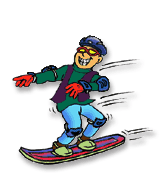 Of those injured on the slopes, many sustained life-threatening injuries, including serious head trauma and spinal injuries.
Of those injured on the slopes, many sustained life-threatening injuries, including serious head trauma and spinal injuries.
Safety Tips
Before They Hit the Slopes
- Skiing and snowboarding are strenuous sports that put heavy demands on muscles, tendons and ligaments in many parts of the body. Make sure your child is in good physical condition before attempting these activities.
- Have your child take professional skiing or snowboarding lessons.
- Make sure your child knows how to handle a fall. Skiing and snowboarding injuries commonly occur when you try to avoid a fall or brace yourself against a fall.
- Review the safety tips of skiing and snowboarding with your child.
Equipment
- Make sure the ski or snowboarding equipment your child uses is in good condition and fitted for his or her weight, size and skill.
- Purchase a helmet specially designed for skiing and snowboarding and make sure your child wears it to prevent head injuries. These special helmets consist of three layers and are cut higher in the back than in the front to allow for the tuck position in racing. The outer shell varies in different models, but protects against objects penetrating the shell. The middle layer consists of a material called polystyrene, which absorbs shock during a fall. The inner layer is designed to provide warmth so no other headgear is required. A head gaiter made of polypropylene or silk can be worn for extra warmth.
- Do not substitute helmets that were designed for another sport. Bike helmets do not provide enough protection for skiing. Other helmets are too heavy and bulky and may cause whiplash injuries.
- A helmet should be selected according to the level of ability and speed your child skis. Never purchase a helmet that is too large for your child’s head. If you rent a helmet, make sure it fits properly – there should be minimal sliding when wearing the helmet.
- Always replace the helmet if it has sustained a significant blow.
- Wrist guards and knee pads should be worn by snowboarders.
- Sunglasses and goggles will protect your child’s eyes and help him or her see better on the slopes.
- Have your child use sunscreen and lip balm to prevent sunburn, even on cloudy days.
Clothing
What your child wears on the slope can help prevent hypothermia and frostbite. Make sure your child dresses to stay warm and dry. Multiple light layers are best. Look for outerwear that is water and wind resistant. Be sure to include:
- Thermal underwear
- Ski pants – no jeans
- Turtleneck
- Neck gaiter
- Sweater
- Vest
- Socks or sock liners
- Jacket
- Hat or headband (60 percent of the body’s heat is lost through the head
- Gloves
On the Slopes
- Supervise children while they ski and snowboard.
- Never let children ski or snowboard alone.
- Be aware of the weather and snow conditions before starting out. Make adjustments for the conditions as they change.
- Have your child study a map of the ski area and be familiar with the terrain and any obstacles.
- Instruct your child to ski and snowboard only in areas matching their ability. Skiers and snowboarders get hurt when they are going too fast and lose control.
- Begin the day with stretching and a few runs down easy slopes to get “warmed up.”
- Remember to tell your child to ski/snowboard within his or her limits.
- Ensure children drink plenty of fluids and eat nutritious food throughout the day.
- Encourage children to take plenty of rest breaks and to stop when they get tired.
Teach Children the Responsibility Code from the National Ski Patrol
- Always stay in control, and be able to stop or avoid other people or objects.
- People ahead of you have the right of way. It is your responsibility to avoid them.
- You must not stop where you obstruct a trail, or are not visible from above.
- Whenever starting downhill or merging into a trail, look uphill and yield to others.
- Always use devices to help prevent runaway equipment.
- Observe all posted signs and warnings. Keep off closed trails and out of closed areas.
- Prior to using any lift, you must have the knowledge and ability to load, ride and unload safely.









 Of those injured on the slopes, many sustained life-threatening injuries, including serious head trauma and spinal injuries.
Of those injured on the slopes, many sustained life-threatening injuries, including serious head trauma and spinal injuries.